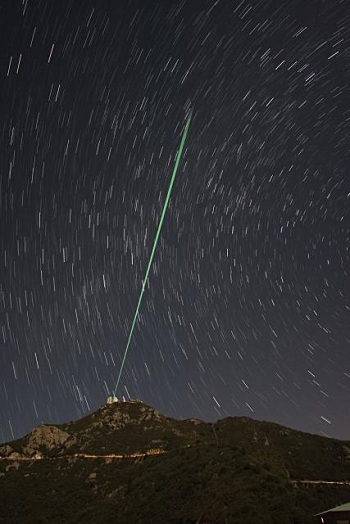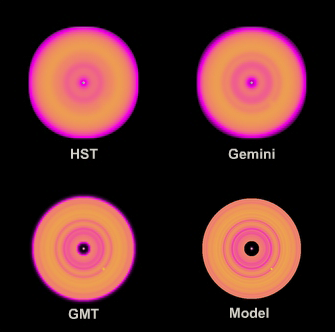Anything we can do to advance the cause of adaptive optics is all to the good. It’s obvious that a space-based observatory is preferable if we want to get the sharpest look at a distant object, but launch costs are still high and the kind of intricate interferometry missions that will one day let us take a close look at a distant exoplanet are still on the drawing boards. In the interim, learning how to get around the distortion caused by a planetary atmosphere allows us to do things with Earth-based telescopes that earlier astronomers wouldn’t have thought possible.

The kind of laser adaptive optics in use at the University of Arizona represents a useful advance in the state of the art. Make a telescope mirror pliable enough to respond to hundreds of actuators positioned on its back side and you can create a series of tiny adjustments as you look at the sky. The adjustments are necessary because atmospheric turbulence blurs the image, the result of rising heat disturbing the air a few thousand feet above our heads. Astronomers use a laser beam to create an artificial ‘star’ that gives them data about the turbulence. All of that information then goes into the computer that controls the mirror.
Image: A bundle of laser beams creates five artificial stars in the night sky above Mount Hopkins in Southern Arizona. Laser light reflected by air molecules is analyzed by a computer that drives the actuators on the adaptive mirror. (Image courtesy of Thomas Stalcup).
In the case of the work being done at Arizona by Michael Hart and team, there is not one laser ‘star’ but five. The 336 actuators on the back side of their telescope’s adaptive mirror smoothly alter its shape thousands of times each second. While techniques like these have grown increasingly sophisticated over the past two decades, Hart’s work is extending adaptive optics to a broader field of view. Until now, atmospheric blurring could only be canceled along a relatively narrow line of sight. Hart loses a bit of resolution to gain the larger field of view.
The result: The oldest galaxies, formed around ten billion years ago, become more susceptible to study. Hart says the new technique extends the range of observation:
“To understand the evolution of those ancient galaxies, we have to observe thousands of them and study their spectral characteristics and chemical composition, and taking a spectrum of a high red-shift galaxy takes a long time because they are so faint… With our new adaptive optics technique, you can now observe dozens at a time. Sampling thousands of galaxies’ spectra becomes feasible.”
Where next for adaptive optics? The current work allows cancelation of atmospheric turbulence over a field of two arc minutes (one-fifteenth of a full moon). Extending it to future instruments like the Giant Magellan Telescope should push its boundaries much further. The GMT is scheduled for completion in 2018, using a 24.5-meter primary mirror with adaptive optics that should be capable of producing images up to ten times sharper than those taken by the Hubble Space Telescope. Its uses in exoplanet discovery and observation, in addition to its other duties in astrophysics, should make it a potent competitor to space-based systems as we develop the skills and resources for the latter to take the next big step.

Will the GMT be able to see Earth-analogues around other stars? We know how tricky this will be. A planet of Jupiter’s size and orbit reflects only 10-9 of its star’s visual light, while a planet like Earth reflects only 10-10 of that light. But have a look at the image, which shows a young protoplanetary disk with embedded planet. A newly formed terrestrial planet at 1 AU is molten, with a temperature of 1500 K, its thermal emission capable of being detected in the mid-infrared range until the planet cools to the point where it becomes undetectable. As for intermediate age stars (around a billion years old), the GMT Science Case makes this point:
A survey of 100 intermediate age (~1 Gyr) stars within 10pc is likely to yield dozens of massive planets at larger radii than those probed by the radial velocity surveys. The Webb telescope will also be a powerful tool for addressing this issue, but the superior resolving power of the GMT will allow it to probe to larger distances and smaller orbital diameters.
Image: A model calculation of an evolving protoplanetary disk with an age of 30 million years as imaged with a perfect telescope (lower right), the Hubble Space Telescope, the Gemini 8m and the GMT, the latter two operating with extreme AO at 1.65μm. The GMT image reveals gaps and other structure in the disk, as well as the terrestrial mass protoplanet. Credit: GMT Consortium.
Adaptive optics working with an instrument like the GMT is suited for many more tasks than exoplanet hunting, of course, including investigations into the properties of dark matter and dark energy. What we’ve learned by building new instruments and extending the powers of those we already have, though, is that many of the discoveries they go on to make are utterly unanticipated by their builders. We can assume the same result from the new generation of AO-augmented telescopes that will so sharply increase the quality of Earth-based observation.



2018 for the first light it’s an interesting date : one year after the nominal end of the Gaia mission.
Amongst the other things, Gaia is expected to detect every Jupiter within 150 ly with orbital period of 1.5/9 yrs, providing a list of potential target to these new giant telescopes coming online.
See “Planet detection” here :
http://sci.esa.int/science-e/www/object/index.cfm?fobjectid=28890
See also :
http://sci.esa.int/science-e/www/object/index.cfm?fobjectid=40577
What is particularly interesting is the partial characterization of our stellar neighborhood, unlike COROT and Kepler that will give us planetary statistics on a wide range of distances.
SIM is supposed to be capable of finding earth sized planets around ~60 close stars (more stars for bigger planets) but I believe that its launch is postponed indefinitely.
Amazing article, again demonstrating the awe inspiring ingenuity of engineers to overcome previously show stopping limitations in imaging distant objects.
FYI, I’m guessing ‘you can create a serious of tiny adjustments’ should read ‘you can create a series of tiny adjustments’
Right you are, Parmanello, and I’ve corrected the mistake — thanks!
To what extent do these sorts of ground-based telescopes obviate the need for space-based resources? And at what wavelengths does adaptive optics work (I presume, for example that this tech wouldn’t work in the IR domain, so the James Webb is still necessary)?
I remember in my youth when the only way we thought we would know anything about exoplanets would be if we could send an interstellar mission to explore another star system. Feasible 100,200,500 how many years in the future?
High praise to the visionary scientists and engineers who have developed methods to scrutinize the information that is arriving at light speed from alien solar systems.
What wonders these further developments will reveal to us. We truly live in the best of times my brothers and sisters.
To Tulse, as I understand it,most adaptive optics systems now in use are optimized for the near infra-red. That may change with further refinements.
Very nice article! just to add a small point: Micheal’s group is pioneering the work of first time modeling the turbulence in 3 dimensions, thats why they use 5 AO laser stars where all ‘penetrate’ the atmosphere in slightly different depths.
Tulse: yes the AO is done mostly on near IR and optical. And no AO system will be able to solve the problem of atmosphere completely blocking parts of the EM radiation, it only solves the problem of atmospheric turbulence to the EM radiation part, which it allows through. So we need JWST, which works in 0.6~2.8micron region, where there are several gaps completely blocked by the atmosphere. On the other hand even for the IR windows that are transmitted through the atmosphere, the AO will have a very hard time beating JWST resolution because of the longer wavelengths. JWST with a mirror of the size of the MMT telescope above in the post will have no better resolution than the HST, though it has more than 7 times more light collecting area..